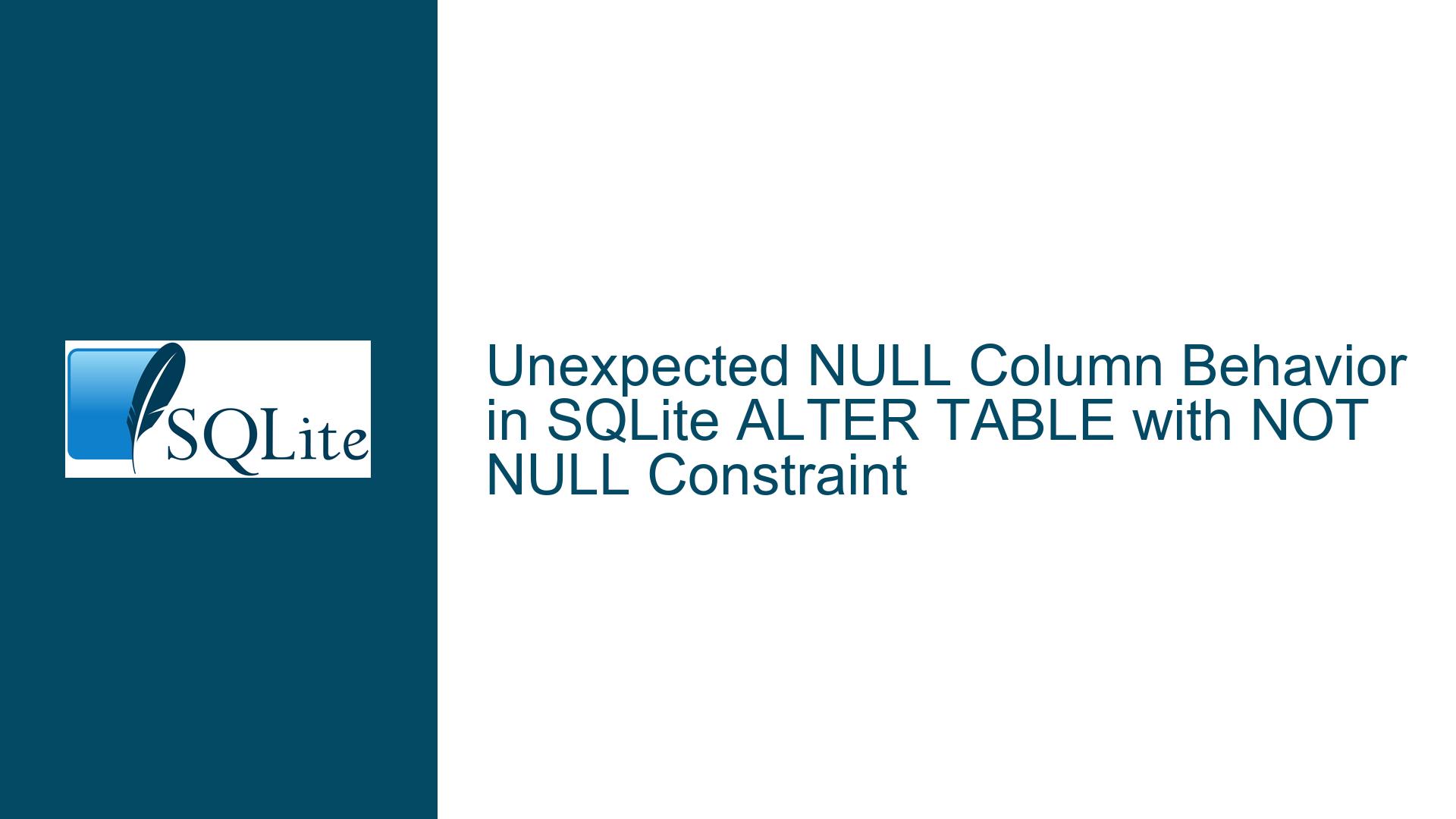Unexpected NULL Column Behavior in SQLite ALTER TABLE with NOT NULL Constraint
Issue Overview: ALTER TABLE with NOT NULL Constraint on Generated Column
The core issue revolves around the behavior of SQLite when adding a generated column with a NOT NULL constraint using the ALTER TABLE statement. Specifically, the problem arises when a column is defined as a generated column (computed at access time) with a value of NULL and a NOT NULL constraint. This combination leads to unexpected results in subsequent queries, particularly when the column is used in a WHERE clause with a NOT IN condition.
The example provided in the discussion demonstrates this issue clearly. A table v0 is created with a single column v1, and a row is inserted with the value 255. Then, a generated column v3 is added to the table with the expression AS (NULL) and a NOT NULL constraint. The subsequent query attempts to select rows from v0 where v3 is not in the result of a subquery that counts the rows in v0. The expected result is NULL, but the actual result is 255|, which is unexpected.
The confusion stems from the fact that the NOT NULL constraint is not enforced at the time the column is added, but rather when data is inserted or updated. This leads to a situation where the column v3 is effectively NULL at the time of the query, but the NOT NULL constraint is not violated because no data has been inserted or updated in the table since the column was added. This behavior is inconsistent with the expectation that the NOT NULL constraint should prevent the column from ever being NULL, even in a generated column.
Possible Causes: Misunderstanding of Generated Columns and NOT NULL Constraints
The root cause of this issue lies in the misunderstanding of how generated columns and NOT NULL constraints interact in SQLite. Generated columns, also known as computed columns, are columns whose values are computed at the time of access based on an expression. In this case, the expression is NULL, which means that the column v3 will always have a value of NULL when accessed.
The NOT NULL constraint, on the other hand, is a constraint that ensures that a column cannot have a NULL value. However, in the case of generated columns, the NOT NULL constraint is not enforced at the time the column is added. Instead, it is enforced when data is inserted or updated in the table. This means that the NOT NULL constraint does not prevent the column from being NULL at the time of the query, but rather prevents NULL values from being inserted or updated in the column.
This behavior is further complicated by the fact that SQLite does not throw an error when adding a generated column with a NOT NULL constraint and a NULL expression. This is because SQLite does not validate the NOT NULL constraint against existing rows at the time the column is added. Instead, it only validates the constraint when data is inserted or updated. This can lead to situations where the column appears to violate the NOT NULL constraint, but no error is thrown because the constraint has not yet been enforced.
Another contributing factor is the way SQLite handles NULL values in expressions. In SQLite, any operation involving NULL results in NULL. This includes comparisons, such as those used in the WHERE clause of a query. In the example provided, the expression v3 NOT IN (SELECT count(*) FROM v0) evaluates to NULL because v3 is NULL. However, the WHERE clause treats NULL as FALSE, which means that the row is not filtered out as expected. This leads to the unexpected result of 255| being returned.
Troubleshooting Steps, Solutions & Fixes: Addressing the Unexpected NULL Column Behavior
To address this issue, there are several steps that can be taken to ensure that the behavior of generated columns with NOT NULL constraints is consistent with expectations.
1. Validate NOT NULL Constraints at Column Creation Time:
One solution is to modify SQLite to validate NOT NULL constraints at the time the column is added, rather than waiting until data is inserted or updated. This would ensure that the constraint is enforced immediately, preventing the column from ever being NULL. This approach would require changes to the SQLite source code, specifically to the ALTER TABLE command, to validate the NOT NULL constraint against existing rows at the time the column is added.
2. Use a Default Value Instead of a Generated Column:
Another solution is to avoid using generated columns with NOT NULL constraints altogether. Instead, a default value can be used to ensure that the column is never NULL. For example, instead of adding a generated column with the expression AS (NULL), a default value of 0 or another non-NULL value can be used. This would ensure that the column always has a value, and the NOT NULL constraint would be enforced as expected.
3. Modify the Query to Handle NULL Values Explicitly:
If it is necessary to use a generated column with a NOT NULL constraint, the query can be modified to handle NULL values explicitly. For example, the WHERE clause can be modified to include a check for NULL values, ensuring that rows with NULL values are filtered out as expected. This approach requires careful consideration of the query logic to ensure that NULL values are handled correctly.
4. Update SQLite Documentation:
The SQLite documentation should be updated to clarify the behavior of generated columns with NOT NULL constraints. Specifically, the documentation should explain that the NOT NULL constraint is not enforced at the time the column is added, but rather when data is inserted or updated. This would help users understand the behavior and avoid unexpected results.
5. Use PRAGMA quick_check to Validate Constraints:
In newer versions of SQLite, the PRAGMA quick_check command can be used to validate constraints after adding a new column. This command checks the integrity of the database and ensures that all constraints are satisfied. If any constraints are violated, the ALTER TABLE command is aborted and the changes are rolled back. This approach can be used to ensure that the NOT NULL constraint is enforced immediately after adding the column.
6. Avoid Using NOT NULL Constraints on Generated Columns:
Finally, it is generally advisable to avoid using NOT NULL constraints on generated columns unless absolutely necessary. Generated columns are intended to be computed at access time, and adding a NOT NULL constraint can lead to unexpected behavior, as demonstrated in the example. Instead, consider using a regular column with a default value or modifying the query logic to handle NULL values appropriately.
Conclusion:
The unexpected behavior of generated columns with NOT NULL constraints in SQLite is a result of the way SQLite handles constraints and NULL values. By understanding the underlying causes and taking appropriate steps to address the issue, users can ensure that their queries and schema designs are consistent with their expectations. Whether through modifying the SQLite source code, using default values, or updating the query logic, there are several approaches to resolving this issue and preventing unexpected results in the future.






